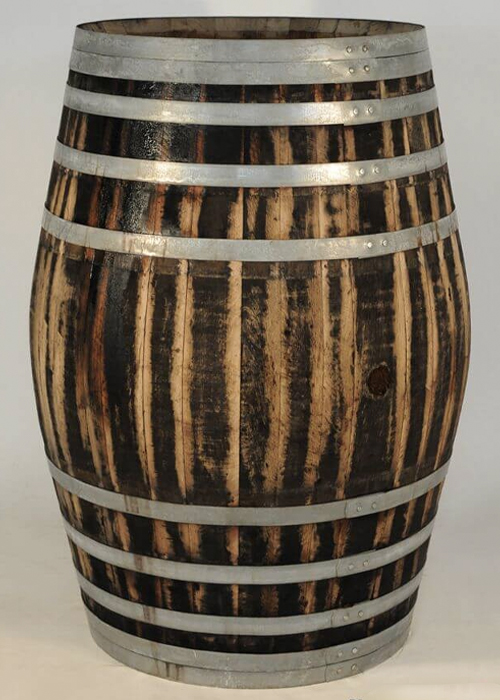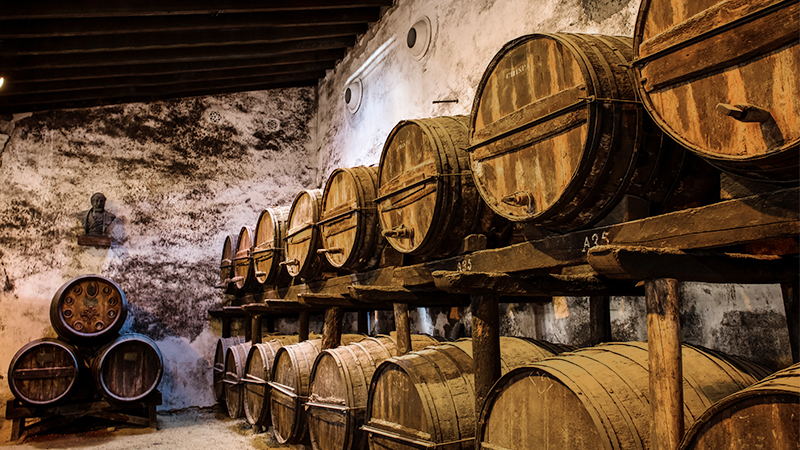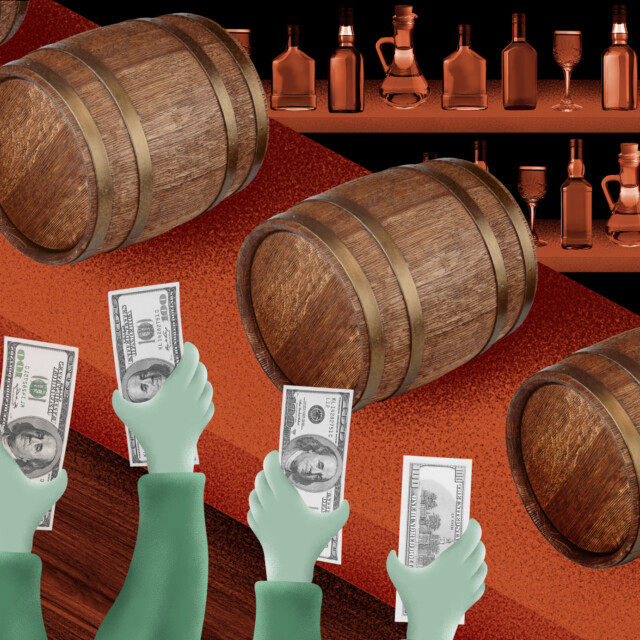It’s like a boozy version of the chicken-or-the-egg problem: Sherry cask whiskies are wildly popular, but, generally speaking, sherry itself is not. If people aren’t really drinking sherry, where do sherry casks come from?
Like sherry, sherry casks are supposed to come from a specific place: the Sherry Triangle in southwestern Spain, located between the cities of Jerez de la Frontera, Sanlúcar de Barrameda, and El Puerto de Santa María in the province of Cádiz. For centuries, this region has produced legendary sweet and dry wines — all broadly known as sherry — using the solera process, which fractionally blends new vintages with older vintages, aging them in a series of wooden barrels. Originally, a sherry cask was simply that: a wooden cask that had been used to make sherry — or, more commonly, to ship it overseas. But in 1986, Spanish law changed and the export of sherry in wooden casks was banned, rendering the previous concept of a sherry cask obsolete.
An Inexpensive Resource
Until that change, quite a lot of sherry casks were going to the U.K., which was once the world’s largest consumer of the drink. Being both thrifty and clever, people there soon found a use for those empty barrels, as Henry H. Work, the author of “Wood, Whiskey and Wine: A History of Barrels,” explains.
“Previously, they were shipping barrels of sherry to places like London and then they would bottle the sherry there and sell it,” he says. The leftover barrels made for an attractive and inexpensive resource. “These were opportunistic. They were cheap. They didn’t need to buy new barrels.” But once that law came into effect in the 1980s, things changed. “ The barrels could no longer be shipped, so the Scotch whisky distilleries no longer had the resource of the used sherry barrels,” Work says.
But at that point, it wasn’t just thrift or resourcefulness that were pushing the use of former sherry casks. Great fino, oloroso, palo cortado, Pedro Ximénez, and amontillado sherries can be wonderfully complex, with rich notes of dried fruit, nuts, leather, and other enticing characteristics. Some of that flavor and aroma complexity was being appreciated by Scottish distillers and their customers, Work says.
“If they thought there was some advantage for using the sherry barrels, i.e., a specific taste that their customers liked, they would want to continue doing that,” he says.
Initially, any lack of sherry character could be fixed with a dose of paxarette, a Spanish dessert wine commonly used to recondition — here meaning add flavors back into — old, worn-out sherry casks. However, in 1990 the legal regulations governing Scotch whisky, known as the Scotch Whisky Order, were changed. From then on, paxarette was considered a flavoring agent, and its use in the production of Scotch whisky was banned.

Those two legal rulings led to the growth of an important new business in the Sherry Triangle: the sherry cask trade, which produces sherry-seasoned casks for export. Today, Work notes, there are really two types of sherry casks made in the Sherry Triangle.
“One goes into the solera process, and that stays in that solera for years and years and years. It grows patina around the outside, from the ambience of the mold and fungus growing in the area, and it gets the sherry flor inside,” he says. “And there’s another kind of barrel that the coopers are making, and basically these coopers are making an export-style barrel.”
An Important New Product
These exported, sherry-seasoned barrels were primarily made for the Scotch whisky industry, though their popularity has since expanded to include many other drinks. Because of Spanish law, they cannot be used to export sherry. Nor are they generally used to make sherry itself — at least not the kind people drink. Instead, they are filled with an inexpensive, relatively young sherry that is specifically made to season casks for export. Markus Eder, a dealer of used and new barrels including sherry casks at Wilhelm Eder in Germany, notes that this sherry can be used to make as many as a half-dozen sherry casks.
“After you repeat this process of the seasoning for about five or six times, you cannot use this sherry anymore. So you produce vinegar out of it, or you throw it away,” he says. “I know bodegas in Spain who make a million liters of sherry only to season casks. Basically, the sherry industry is only working for the Scottish whisky industry.”
That might sound like an exaggeration, but the scale of today’s sherry cask business is truly surprising. Due to the ongoing whiskey boom, its importance is growing, in contrast to the collapse of the sherry wine industry. Total annual sales of sherry are only about a fifth of what they were at their peak three to four decades ago, dropping from around 150 million liters a year to around 30 million liters in recent years, as sherry educator Ruben Luyten has reported at sherrynotes.com. (By contrast, just the export market for Scotch whisky was about 1 billion liters in 2021.) Recent articles might have argued that sherry is seeing growth in some markets, citing an increase in the export of quality dry sherry, but Luyten points out that any improvements in the sales of dry sherry are offset by continuing losses in sweet versions. As a whole, the sherry wine industry is just much smaller now than what it once was.
“I don’t think the related turnover and profits are being disclosed, but I wouldn’t be surprised if the sherry cask industry overtook the wine industry,” Luyten says.
Some back-of-the-envelope math shows that this might have already happened, at least in terms of the number of barrels. Some 84,100 sherry casks were exported last year, Luyten says, while he calculates the volume of all sherry wine sold last year as only adding up to about 63,600 casks.
That means that the sherry-seasoned cask industry has gained an important role in the Sherry Triangle, keeping cooperages, vineyards, and winemakers all in business, even if it’s not primarily the business of making the sherry that people drink. In 2015, the Consejo Regulador regulatory council that controls the “Jerez-Xérès-Sherry” DOP began regulating the term “sherry cask” as well, offering a certification of authenticity and a number of regulatory standards: primarily, that sherry casks must be filled with sherry that comes from the Jerez-Xérès-Sherry DOP, and that each cask must be originally filled to at least 85 percent of its volume and stay at least two-thirds full for at least one year.
César Saldaña, president of the Consejo Regulador, says that the average age of a sherry cask is slightly higher than the bare minimum, however.
“In fact, the average seasoning at this point in time is 18 months,” he says. “For some of the operators here in Jerez, this has become a very important business.”
He notes that the Consejo Regulador is planning to expand the regulations on casks that it launched in 2015. The next step will be to create a register of distillers that are purchasing certified sherry casks.
“Until we regulated the ‘sherry cask’ term, there were a lot of distillers that were buying their casks in different parts of Spain, casks that were seasoned with different types of wines,” he says. “Now, with this second step, we’re going to make sure that the producers that use the term ‘sherry cask’ on their labels are in fact using a real sherry cask.”
Pluses and Minuses
Although today’s sherry casks differ from both production casks and the barrels that were used for export before 1986, they’re not necessarily a step down. This month, Edinburgh’s Innis & Gunn brewery released the Original: PX, a special, sherry-cask version of its classic barrel-aged beer finished in a mix of first-fill Pedro Ximénez hogsheads, or 250-liter casks, and second-fill Pedro Ximénez butts, or 500-liter casks. Dougal Gunn Sharp, the brewery’s founder and master brewer, notes that modern sherry finishing casks can offer advantages over production barrels or the former shipping casks.

“In some respects, this improves the quality and processing of the finished product,” he says. “The consistency of the barrels has improved substantially. It’s also more sustainable.” For his sherry-finished beer, Sharp was hoping to achieve some of the characteristics of Pedro Ximénez dessert wine: fruity, spicy aromas, a sweeter flavor profile, and hints of chocolate and banana. Those all came through, he says.
“It’s absolutely delicious, one of the tastiest limited-edition beers we’ve ever brewed,” he says. While sherry-finished beer remains a relative rarity, the use of sherry casks in Scotch whisky shows little sign of slowing down: Luyten notes that three times as many sherry casks were sold compared to just five years ago. Cost advantages mean that they’re now generally made from imported American oak, which can be half the price of French or Hungarian oak, according to Work.
As a vestigial tail of the old wine and spirits trade, sherry casks can be hard to get your head around, even for those in the drinks industry. Eder says that the most common misunderstanding he encounters is a customer who thinks he can easily buy a barrel that has been used to produce sherry for many decades, instead of a new, American oak cask that has been seasoned with sherry for just 12 months. Older, well-used production barrels still exist, he says, though they generally only have about seven years of age nowadays. They’re not easy to find, he says, and they’re certainly not cheap.
“If you are trying to find a cask which is really old, then you have to spend the money,” he says.
The idea that Scotch producers are not allowed to flavor their whiskies, he says, is hard to square with the fact that most sherry casks are produced specifically for the Scotch whisky industry, after which the sherry might be dumped or made into vinegar. If the sherry used to season sherry casks is not actually a drink, then what is it?
“More or less, it’s only a flavor,” he says. “My opinion is that it would be more honest to allow an additive like paxarette.”
This story is a part of VP Pro, our free platform and newsletter for drinks industry professionals, covering wine, beer, liquor, and beyond. Sign up for VP Pro now!
